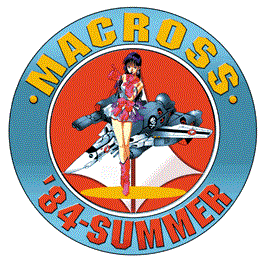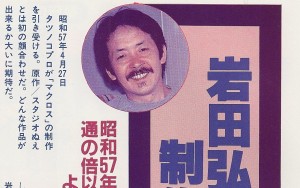Time to break up the toy news for a bit and take a little history lesson.
Hiroshi Iwata was a producer for the original Super Dimension Fortress Macross series – a series beloved and berated by fans for its at-times-incredible, at-times-abysmal visuals, the result of round-the-clock blood sweat and tears. The book “Macross Graffiti” features an intriguing interview detailing his impressions regarding his experiences working on the show. It is always fascinating to read about the production history of the series and here we have another fine example, encapsulated in time, of the sentiments of the Macross staff as they look back on their struggle, still fresh in their memory.
Hiroshi Iwata’s journal of the Great “Macross” Production Struggle
Originally printed in Best Hit Series Super Dimension Fortress Macross: Macross Graffiti (Akita Shoten, 1983) – Translation by Renato
September 1st, 1982. The May start with over twice the average length of a pre-production period suddenly turned into the schedule from hell. It was a mire of problems that somehow we had to overcome!
April 27th, 1982. Tatsunoko Pro agrees to work on the production of “Macross”. It was the first meeting with Studio Nue – there was great excitement about what kind of show would come from this collaboration.
What kind of impression did you have when it was decided that production work would be done on “Macross”?
Iwata: Firstly, it was the first time for us to do a real mecha show, so I anticipated many new challenges. For Studio Nue, too, it was their first original project so they were very enthusiastic, and we were really looking forward to new developments that would come about.
When did the real work begin?
Iwata: Around the time after the May holidays. Since we started in May with the broadcast due to commence in October, meaning it was twice the normal pre-production period length, we totally thought we had it so easy (laughs). In reality, though, it was tough.
May 14th, 1982. Meetings are held every day, every night. To the surprise of everyone, the main mecha, the “Valkyrie”, is revealed.
Tell us about your impressions upon seeing the Valkyrie.
Iwata: After first of all thinking that such a realistic-looking design must be a first in the history of anime, my next immediate thought was, “who the hell is going to make this thing move?” (laughs)
I thought that if this could manage to move then it would be fantastic, and if we had not had (Ichiro) Itano on board then it would not have moved as cool as it looked. This was the point in time at which it gradually stopped being the case that anybody could work on a show provided they had some technical skills as an animator. This was because from here on in, more and more of the designs that appeared called for particular expertise and talent.
June 8th, 1982. The staff roles began to be finalized. A brief look around brings the realization that many of the staff members are young enough that they were up until very recently in the “viewer” camp, rather than the “creator” one. Something amazing was anticipated. The schedule begins to be delayed. One supposes it cannot be helped as a result of their lack of real production experience, but still….
From June onwards, problems arise in the schedule…?
Iwata: From the latter half of May, I began to suspect things would get tough. In particular, the storyboards and the animation frames. Because of their passion towards the project, it would take forever to receive the approved designs. When you are making a series, sometimes you have to compromise those things and prioritize the schedule. If one part is delayed, everything else is affected, and you make trouble for all the rest of the staff.
August 12th, 1982.
Information about “Macross” begins to circulate in the anime magazines, and to favourable response.
(Haruhiko) Mikimoto’s illustration for the August issue of “My Anime” on July 10th is also very popular. All that’s left is to concentrate on the series. We must give it our all!
What did you think of Mikimoto’s characters?
Iwata: I thought they were good. However, there is an “illustration”-like element to them in their use of colour, which, when it comes to animating them, brings about some difficulties. He’s definitely talented, so I am looking forward to seeing what he does next.
April 24th, 1983. The broadcast of “Love Drifts Away” brings about a brief sense of closure. The enormous amount of agony in the production process aside, it perfectly showcased the “newness” of the young staff and how they had managed to come so far.
September 25th, 1982.
One week to broadcast. It is decided that the first and second episodes will air back to back, and the staff face a struggle tougher than ever. The theme song is also good. I wrote some lyrics, too, but it appeared that the music of “Macross” would also become a powerful weapon.
The lyrics were by Asa Akane, in other words, a collective pen-name for the staff. Does that include you, Iwata-san?
Iwata: Yeah. We figured that if we outsourced them to someone we would have to explain the image and specific details of all the settings, so we just did it ourselves. I wrote the opening, “My Boyfriend is a Pilot”, “Silver Moon, Red Moon”, “Love Drifts Away” and “Sunset Beach”. The one we actually discussed was the opening, really, the rest were all OK’d on the spot.
Do you have experience with music?
Yes, though I’m not a pro. I think that because there were people in the staff who understood music, such as (Chief Director Noboru) Ishiguro-san and (Recording Director Yasunori) Honda-san, we were successful in considering the effect of songs within an anime work.
What do you remember regarding the lyrics?
I wrote “My Boyfriend is a Pilot” in about 10 minutes. This was supposed to be the debut song, and so since Hikaru is a pilot, I borrowed from the old song “My Boyfriend is Left-handed”. As soon as I came up with “kyuun, kyuun”, the rest wrote itself (laughs).
How did the usual songwriting process go?
The songwriting process was basically, we made a menu, and then we had to figure out what image the debut song should have, or at this point in the story we should have this song, that was it in a nutshell. For “Love Drifts Away”, we wanted to have a song in the style of “Lili Marleen”.
In any case, by using the power of song, we too managed to induce a “shock” in the viewer in the same way as was done with the Zentradi in the show (laughs). The usual TV station giveaways of [analogue] records normally gathered about ten thousand applications, but for “Macross” the number was 30,000. I hear that sales were also record-breaking, and so in terms of the songs, I am very satisfied that everything went according to plan.
20th December 1982: Episode 11, “First Contact”, somehow avoids catastrophe. Through the efforts of Messrs.’ Uchiyama and Sato, the seisaku-shinkou*, and the rest of the sleep-deprived staff, the episode manages to pull through and make it to broadcast. Had it not made it to broadcast, the entire show was looking at a worst case scenario of cancellation. Yet, criticism from the fans was loud and clear. The production staff realized that they had to make a special effort to do something to make up for this.
It seems you had it really tough with “First Contact”…
We thought we would die. We were so far behind schedule, we didn’t even have time to paint the cels. The production staff were frantic, right up until the broadcast. So for them, it was important that they get it out and on the air, even in that state. If they missed the airdate, then Macross would probably not be what it is today. I’m sure for them, too, it was really tough to have to put it out in that form. But what I want people to understand is they had no choice but to do that. So we were determined to somehow make it up to the viewers. Episode 27 can be considered one answer to this. In that single episode, they injected three times the usual effort.
June 6th, 1983. Work on the final episode was nearing its end. Looking back, it was a full year of nothing but hard labour. Thank you all for the hard work. To all the young staff, it is now time to leave the nest and make your own paths. Please work hard. Maybe we can meet again for a “Macross” movie, or something.
How do you look back on the show?
I think we have created a new concept of what is possible in animation. I’m really looking forward to seeing what the young guys – Mikimoto, Itano, Kawamori, Hirano – come up with after this. Also, their names are not so prominent, but please let us not forget enshutsu Akiyama and storyboarder Yamada, who also firmly supported this show. It takes more than two or three people to make an animated work. It is the result of collaboration between hundreds of individuals.
This work, for me, is unforgettable. To all the fans, thank you!!
*Seisaku-shinkou: One of the most important of the organizational jobs taken by younger staff other than the artists in the animation industry – it is a sort of production assistant manager position including duties such as organizing schedules, carrying and ordering animation frames from other studios, etc. The seisaku-shinkou should be aware of everything that is happening inside and outside the studio so as to make sure the production runs smoothly and effectively.
Producer Iwata’s Busy Days – Diary of a typical day of Iwata’s activities
AM
8:30 – Get up
9:35 – Arrive at work
- Production meeting at Animefriend. Check progress on production proceedings with the seisaku-shinkou Uchiyama and Sato.
10:30 – Scenario check
- Joint meeting with Ishiguro, Matsuzaki, Kawamori, Tomita, etc. at Tatsunoko.
PM
12:30 – Lunch
- Lunch meeting with MBS Tokyo’s Kishimoto and Tatsunoko Pro’s Inoue regarding the forthcoming developments.
1:30 – Attend recording session.
- After a casual meeting with Senda and Nagata at Victor Studio, attend the recording session for the second LP.
4:30 – Voice-over dubbing
- Abacus Studio. After a meeting with sound director Honda, attend dubbing session. Check the preview comments during the interval. Wait until Ishiguro and Kawamori arrive and then check the progress on the storyboards.
10:40 – Dinner
- After the dubbing, have late dinner with Ishiguro, Matsuzaki, Kawamori and (Noriko) Ohara.
AM
1:20 – Return home
- On return, listen to the tape received today. Note down any impressions and prepare for submission tomorrow. Check tomorrow’s schedule.
3:00 – Sleep
Note by the translator:
AnimeFriend – a studio made up of mostly ex-Tatsunoko staff – has long had a reputation in English-speaking regions for being responsible for the more “off-model”-looking and error-laden episodes, and I have personally on many an occasion tried to quash that fallacy by attempting to explain that in fact Korean studio Star Pro (subcontracted by AnimeFriend) was behind many of those “mistakes”. Mr. Iwata was present at AnimeFriend overseeing the in-house work.
-Renato

